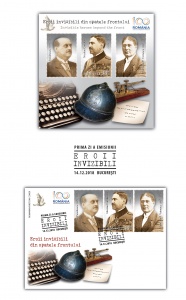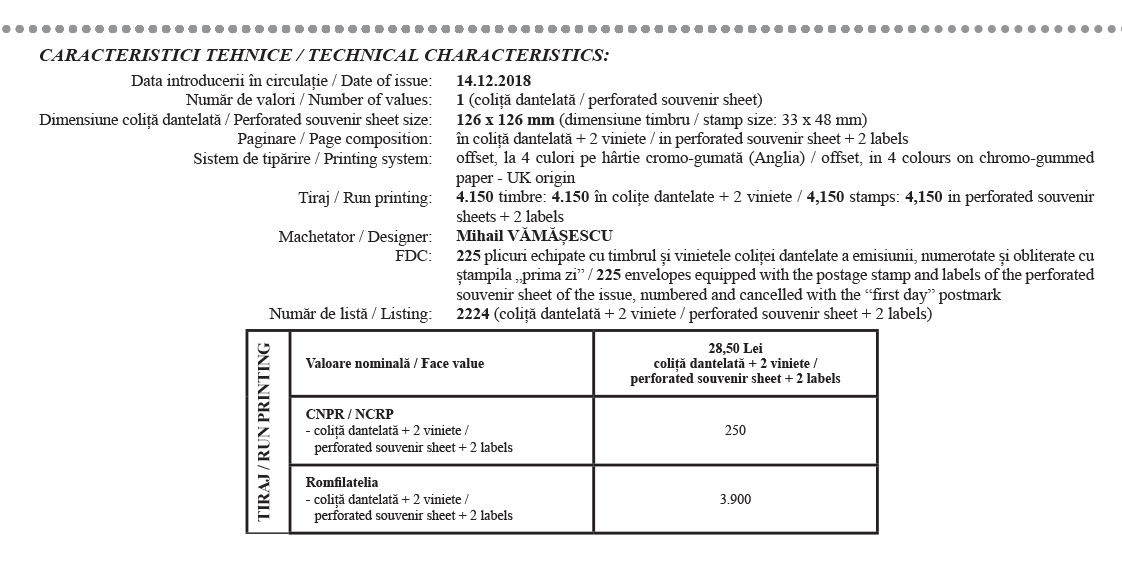 In the Centenary year of the Great Union, Romfilatelia graced the memory of the heroes who fought during the World War I on the invisible front of information, by introducing into circulation the postage stamp issue Invisible heroes beyond the front.
In the Centenary year of the Great Union, Romfilatelia graced the memory of the heroes who fought during the World War I on the invisible front of information, by introducing into circulation the postage stamp issue Invisible heroes beyond the front.
When it entered the Great War, the Romanian army did not have a long and steady tradition of military information departments, a shortcoming that had weighted not a little in the disastrous campaign of 1916. The officers and soldiers were not prepared to cope with the unseen war, and much strategic information was negligently disclosed to the enemy spies who were operating in Romania.
Much better organized were the structures of the Ministry of the Interior, which also contributed to war efforts. Between 1914 and 1919, the Police and General Security Directorate was established, with divisions the Directorate of General Security and the General Police Inspectorate.
During the period of neutrality (1914-1916), foreign intelligence agencies have taken advantage of the Romanians’ willingness to provide information in exchange for money. Himself Nicolae Iorga, who owned the newspaper Neamul Romanesc (Romanian Nation), has publicly rebelled against this situation and wrote the article “How to Fight the Spies”, published in June 1915. The scholar appreciated that the foreign espionage services relied on the general predisposition for bribery, as “We are not a country where someone can be self-conscious”. An Austrian agent arrested by the Police and General Security Directorate confessed that secret talks were taking place in trams, trains, public places, on the street, in the family. Information was being shouted loud in front of anyone about the army, the weapons, the equipment, and the foreign spies only had to listen and collect this information.
In August 1916, when Romania entered the war, the Great General Staff was reorganized to deal with the new war situation. For the operative part, the Great General Headquarters has been activated, and for the sedentary part, the Great General Staff was also operating. Both structures consisted of information offices specialized in information gathering and news surveillance.
However, the Directorate of Police and General Security has carried out counterinformation actions aimed to prevent foreign espionage from acting on the Romanian territory and, if necessary, intoxicating them with fake news. The Directorate set up an intelligence gathering service in various localities around Romania, consisting of permanent and fixed agents, residing in the cities of Odessa, Chisinau, Ungheni, Sumla, Timisoara, Sibiu, Cernauti, Belgrade, Brasov and Rusciuk. Agents were recruited, for the most part, from among the ethnic Romanians in the area, who were selected on the basis of patriotic feelings.
After the withdrawal in Moldova, at the end of 1916, consolidation activities were carried out in the field of information and counterinformation, in the sense of efficiency. Clear procedures have been formulated on how to conduct information and manipulation of information, the duties of staff having informative missions, the establishment of aviation recognition missions and how to conduct flying research, the coordination of secret agents’ activities, etc.
On the perforated souvenir sheet of the issue, with the face value of Lei 28.50, are represented three of the personalities who have stood on the invisible front of information in the years of the World War I: Col. Nicolae Condeescu, Ion Panaitescu and Romulus P. Voinescu. Along with their portraits, on the souvenir sheet we can find a writing machine, a World War I helmet and a Morse code transmission device.
Colonel Nicolae Condeescu (1876-1936) – headed the Information Office of the Great General Headquarters (1916-1918) and the Information Department of the Great General Staff (1918-1919). He worked with British, French and Russian Allied representatives to reorganize the military information field, elaborated informative and counterinformative instructions. He was concerned with setting up information courses for officers and managed the collection, analysis and transmission of information that contributed to winning the battles of Marasti, Marasesti and Oituz.
Ion Panaitescu (1875-1929) – founded and led the Police and General Security Directorate (1908-1919), being the first who introduced the division and conspiracy of work into the professional activity. He managed the collection of external information, the annihilation of enemy agents, the monitoring of public sources, and made security analyses for policy makers. During the time when the Government was established in Iasi, he was appointed Chief of the Security Department of the Great General Headquarters.
Romulus P. Voinescu (1867-1936) – was the delegate of the Police and General Safety Directorate attached to the General Headquarters of the Russian armies in Romania, Head of the Romanian-Russian Counterinformation Department (November 1916 – March 1918) and Head of the Bessarabian Directorate of the Interior (1918-1919). He acted successfully in the counterinformation field and proved a quality management at the leadership of the structures he was in charge of.
Romfilatelia thanks the professor Corneliu Andonie, from the “Ferdinand I” National Military Museum and historian Alin Spanu for the documentary and photographic support granted for the achievement of this postage stamp issue.
















